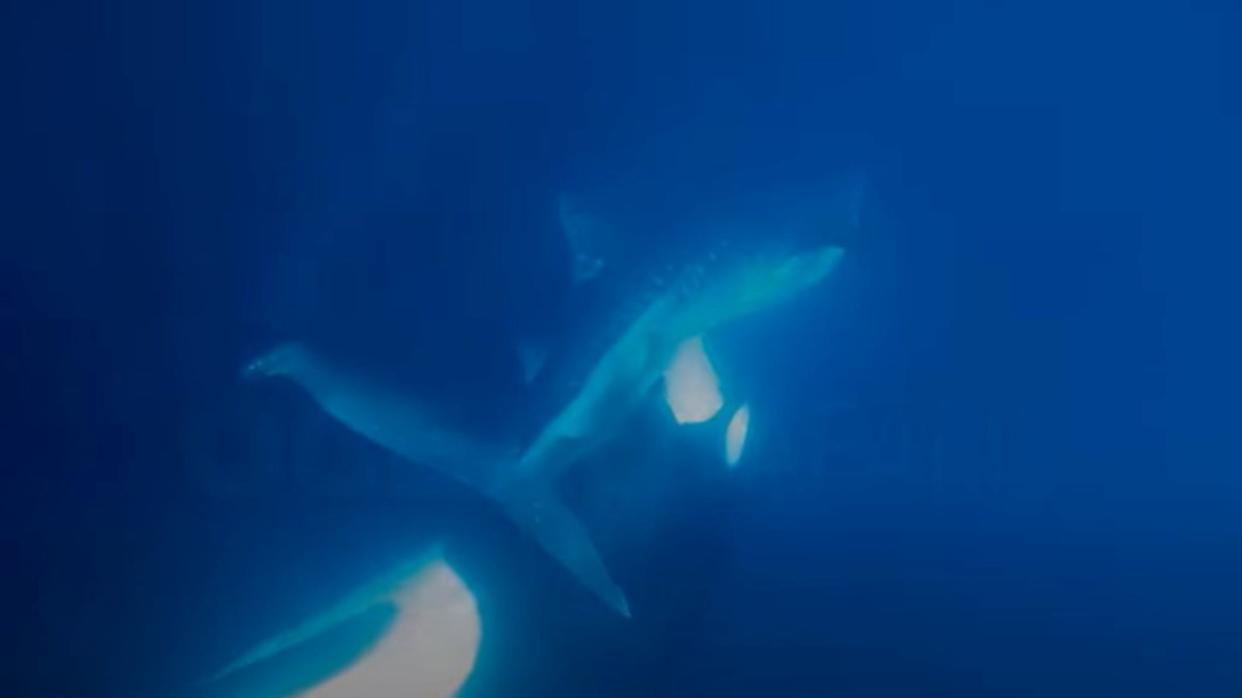Watch orca tear open whale shark and feast on its liver in extremely rare footage


A orca tears open a whale shark and eats its liver off the coast of Baja California, Mexico, shocking new footage shows. The rare video reveals the orca swimming upside down beneath the shark and chomping its underside, with blood spewing from the wound.
After the orca has finished its feast, it pushes itself to the surface as the whale shark's lifeless body sinks below.
The video was taken by James Moskito, CEO of the California-based ocean tour operator Ocean Safaris, during an expedition to the Gulf of California in April. He noticed a whale shark and swam over, coming about 6 feet (1.8 meters) above it when the orcas arrived, he told Live Science. "The killer whales start coming in and next I know they're biting the bottom of it," he said.
Whale sharks (Rhincodon typus) are the biggest species of shark on Earth, growing to around 60 feet (18 m) long. Healthy adults have few natural predators, but calves and injured individuals are known to sometimes fall prey to tiger sharks (Galeocerdo cuvier) and orcas (Orcinus orca).
Related: In rare attack, 30 orcas 'badly wounded' 2 adult gray whales in California
While orcas have been filmed attacking juvenile whale sharks, Moskito's footage appears to be the first known video of the mammals attacking an adult whale shark, which was estimated to be 27 feet (8.2 m) long. "It's literally over in a matter of seconds," Moskito said. "They came in, they bit the bottom of the whale shark. Looks like they slurped in the liver and then the whale shark just fell and descended down, with no movement — I'm assuming it was dead."
Moskito said that shortly after this encounter, he and the others on board saw the orcas attack and kill another whale shark. When they arrived at the location, Moskito said they saw a whale shark "just thrashing at the surface with a killer whale attached to it."
Moskito said that one large, adult orca male known as Montezuma was involved in both of the attacks. "He's a known killer whale, and he was with this different pod this time," Moskito said. "He was not with his normal pod. He was kind of the instigator of the stuff, even though in the video it's a female biting it [the whale shark], not the male."
RELATED STORIES
—Whale sharks are the world’s biggest omnivores, scientists discover
—'An enormous mass of flesh armed with teeth': How orcas gained their 'killer' reputation
—Photo shows 'massive' great white shark scarred after rare battle with 2 serial killer orcas
Shark livers are highly nutritious, filled with fats and oils — and orcas across the globe have been documented engaging in this liver-eating behavior for decades.
"Orcas may have learned that consuming shark livers provides high energy and nutrients," Alison Kock, a marine biologist with South African National Parks, told Live Science earlier this year. "Sharks' livers are large and buoyant, and they float to the surface of the water when a shark is killed. This makes them easy for orcas to spot and access, compared to other organs that may sink to the bottom or be harder to locate."

